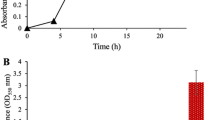Abstract
The P. aeruginosa quorum-sensing molecule N-3-oxododecanoyl homoserine lactone (3OC12-HSL) interacts not only with bacteria, but also with mammalian cells, among others with those of the immune defence system. We focussed on the possible interaction of 3OC12-HSL with human polymorphonuclear neutrophils (PMN), because these cells are the first to enter an infected site. We found that 3OC12-HSL attracts PMN, and up-regulates expression of receptors known to be involved in host defence, including the adhesion proteins CD11b/CD18 and the immunoglobulin receptors CD16 and CD64. Furthermore, the uptake of bacteria (phagocytosis), which is crucial for an efficient defence against infection, was enhanced. Thus, recognising and responding to 3OC12-HSL not only attracts the PMN to the site of a developing biofilm, but also reinforces their defence mechanisms, and hence could be a means to control the infection in an early stage and to prevent biofilm formation.




Similar content being viewed by others
References
Costerton W, Veeh R, Shirtliff M, Pasmore M, Post C, Ehrlich G (2003) J Clin Invest 112:1466–1477
Hall-Stoodley L, Costerton JW, Stoodley P (2004) Nat rev Microbiol 2:95–108
Wiblin RT (1997) In: Wenzel RP (ed) Prevention and control of nosocomial infections, 3rd edn. Williams and Wilkins, Baltimore
Smith RS, Iglewski BH (2003) Curr Oppin Microbiol 6:56–60
Head NE, Yu H (2004) Infect Immun 72:133–144
van Delden C, Iglewski BH (1998) Emerg Infect Dis 4:551–560
DiMango E, Zar HJ, Bryan R, Prince A (1995) J Clin Invest 96:2204–2210
Smith RS, Fedyk Er, Springer TA, Mukaida N, Iglewski BH, Phipps RP (2001) J Immunol 167:366–374
Chun CK, Ozer EA, Welsh MJ, Zabner J, Greenberg EP (2004) PNAS 110:3587–3590
Telford G, Wheeler D, Williams P, Tomkins PT, Appleby P, Sewell H, Stewart GS, Bycroft BW, Pritchard DI (1998) Infect Immun 66:36–42
Smith RS, Harris SG, Phipps R, Iglewski B (2002) J Bacteriol 184:1132–1139
Ritchie AJ, Yam AO, Tanabe KM, Rice SA, Cooley MA (2003) Infect Immun 71:4421–4431
Chhabra SR, Harty C, Hoii DSW, Daykin M, Williams P, Telford G, Pritchard DI, Bycroft BW (2003) J Med Chem 46:97–104
Hooi DSW, Bycroft BW, Chhabra SR, Williams P, Pritchard DI (2004) Infect Immun 72:6463–6470
Vikström E, Magnusson KE, Pivoriunas A (2005) Microbes Infect 7:1512–1518
Zimmermann S, Wagner C, Müller W, Brenner-Weiss G, Hug F, Prior B, Obst U, Hänsch GM (2006) Infect Immun (submitted)
Medzhitov R, Janeway C Jr (2000) Trends Microbiol 8:452–456
Gallucci S, Matzinger P (2001) Curr Opin Immunol 13:114–119
Hargreaves DC, Medzhitov R (2005) J Clin Immunol 25:503–510
Heine H, Ulmer AJ (2005) Chem Immunol Allergy 86:99–119
Tateda K, Ishii Y, Horikawa M, Matsumoto T, Miyairi S, Pechere JC, Standiford TJ, Ishiguro M, Yamaguchi K (2003) Infect Immun 71:5785–5793
Belloc F, Dumain P, Boisseau MR, Jalloustre C, Reiffers J, Bernard P, Lacombe F (1994) Cytometry 17:59–65
Brenneis H, Schmidt A, Blaas-Mautner P, Wörner I, Ludwig R, Hänsch GM (1993) Eur J Invest 23:693–698
Babior BM, Kipnes RS, Curnutte JT (1973) J Clin Invest 52:741–744
Leid JG, Shirtliff ME, Costerton JW, Stoodley AP (2002) Infect Immun 70:6339–6345
Jesaitis AJ, Franklin MJ, Berglund D, Sasaki M, Lord CI, Bleazard JB, Duffy JE, Beyenal H, Lewandowsky Z (2003) J Immunol 171:4329–4339
Author information
Authors and Affiliations
Corresponding author
Rights and permissions
About this article
Cite this article
Wagner, C., Zimmermann, S., Brenner-Weiss, G. et al. The quorum-sensing molecule N-3-oxododecanoyl homoserine lactone (3OC12-HSL) enhances the host defence by activating human polymorphonuclear neutrophils (PMN). Anal Bioanal Chem 387, 481–487 (2007). https://doi.org/10.1007/s00216-006-0698-5
Received:
Revised:
Accepted:
Published:
Issue Date:
DOI: https://doi.org/10.1007/s00216-006-0698-5




